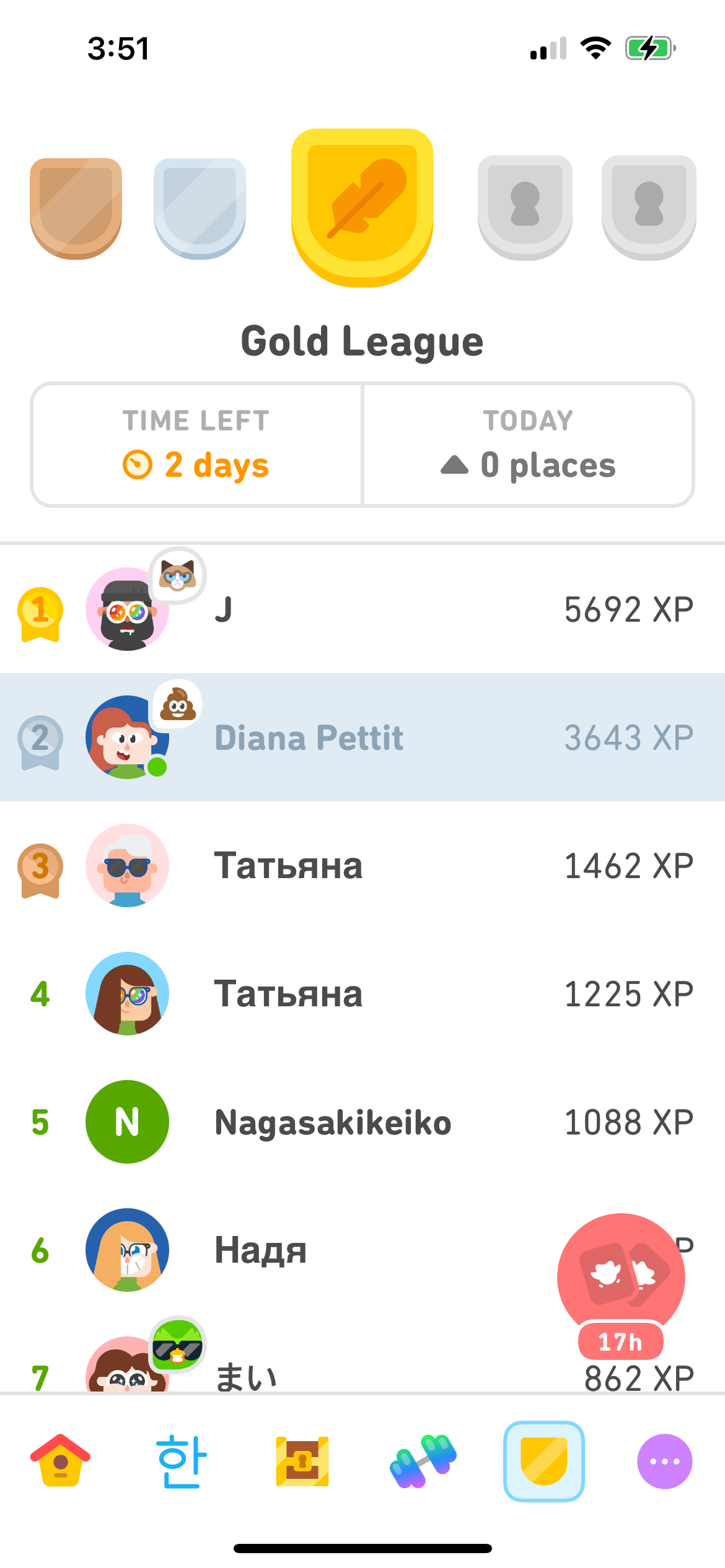Duolingo Leagues: What are They, and How Can They Help You Learn a Language?
• public
Language learning has definitely changed over the past 25 years, partly because of the many new applications being used by language learners across the globe, and Duolingo is one of the most well-known of these apps.
One of my favorite features on Duolingo is the ability to participate in Duolingo Leagues.
I've been testing this feature out for the past few weeks, and although there are many things I don't like about this application, Duolingo Leagues is the main reason I keep coming back for more. In the photo below you can see that I am currently in the Gold League after 3 weeks of continuous use.
Here, I will give a detailed explanation on how to use Duolingo Leagues, plus all the main pros and cons of using them to help you learn a new language.

Finally.... Duolingo Leagues Explained
Duolingo Leagues are an interactive feature in Duolingo. They offer a competitive edge to the language learning experience on the Duolingo platform. The Leagues pit users against each other on the Duolingo leaderboard, providing not only a platform for friendly competition, but also a motivational tool to engage learners.
Every week, users find themselves on a leaderboard with 29 other learners. Language learners are awarded points based on their learning progress and their overall activity on the platform. The leaderboard ranks users based on the points they earn, and at the end of the week, the top performers are rewarded with badges and prizes.
Purpose of Duolingo Leagues
The Duolingo League system was introduced as a motivational tool, and if you are a competitive person, I can say from personal experience that it is very motivational.
It encourages regular language practice by giving learners the chance to compete against each other every week, and gives rewards to the users that use the platform the most. The competitive aspect of the leagues serves to fuel learners' determination and engagement.
The leaderboard then becomes a benchmark for learners to measure their progress and success against others.
Understanding the Duolingo League System
Joining a Duolingo League is simple, and you should be prompted to join a league on Duolingo automatically.
But if you're not, on the Duolingo app or website, you can join a league by going to the "Leagues" tab. It looks like a Golden Shield. Alternatively, you can join a league just by finishing a lesson on Duolingo.
I've been told that there are different leagues available, including a general league for all users and language-specific leagues for each language offered on Duolingo. But I have only seen the general league offered. I am not sure if the language-specific leagues are still being offered.
What are the 10 Duolingo Leagues?
There are ten different leagues in Duolingo, each representing a different level of competitiveness and skill. These are the Duolingo leagues names, from bottom to top:
- Bronze
- Silver
- Gold
- Sapphire
- Ruby
- Emerald
- Amethyst
- Pearl
- Obsidian
- Diamond
The Bronze League is the entry-level league, and the goal is to climb up the ladder to the Diamond League, which is the highest league on Duolingo.
When does Duolingo League End? League Progression in Duolingo.
Every week, the top performers in each league are promoted to the next league. The promotion zone varies from league to league. For example, in the Bronze League, the top 20 users are promoted, whereas in the Silver League, only the top 15 get the ticket to the next league. On the other hand, players in the lowest ranks (24th to 30th) are demoted to the previous league.
From my experience, it's pretty easy to progress to the next league. Even if you use Duolingo for just a few minutes a day, it should give you enough points to make it to the next level. I use Duolingo for around 30 minutes a day, and I have always been in the top 3 spots on the leaderboard.
The Diamond League and Tournament
The Diamond League is the pinnacle of the Duolingo Leagues, and reaching the Diamond League is considered a significant achievement. If you progress every week, it'll still take you almost 3 months to reach the Diamond League. So by the time you get there, you should know a fair amount of vocabulary in your target language.
However, the competition doesn't end there. The top 10 performers in the Diamond League will be eligible for participation in the Diamond Tournament. This tournament has three phases: Quarterfinals, Semifinals, and Finals. It's not an every-week event, so learners need to watch out for a notification at the top of the leaderboard.

Advantages and Disadvantages of Duolingo Leagues
Pros of Duolingo Leagues
- Motivation: The competition provided by leagues can effectively drive learners to keep up with their language learning routine.
- Benchmarking: Leagues offer an easy way for learners to compare their progress and success against others.
- Community: Users can interact with others in their league, creating a sense of community and connection.
Cons of Duolingo Leagues
While leagues can motivate learners, they shouldn't be the sole focus of the learning process. Language learning is a personal journey, and each learner progresses at their own pace. The leagues, though engaging, may sometimes push learners to focus more on competition rather than personal growth.
Plus there are problems with learning language from an app in general. While I think that Duolingo is great for motivation to memorize vocabulary, I wouldn't use it for much else.
It's a game. Games are fun. But you'll need more than a game if you want to become fluent in a second language.
Tips for Success in Duolingo Leagues
- Strategize: Plan your learning routine strategically. Understand when and how to earn points.
- Patience: Wait for the right moment to join a league. This can increase your chances of being grouped with more casual learners.
- Consistency: Regular practice is the key. Make it a point to complete lessons and challenges regularly.
- Balanced Approach: Remember that Duolingo is just a part of your language learning journey. Don't forget to supplement it with other resources like courses, language exchange programs, and immersive experiences.
The Social Aspect of Duolingo Leagues
Duolingo Leagues provide a social aspect to language learning. Users can interact with others, compete against them, and even learn from each other. However, users should keep in mind that the ultimate goal of using Duolingo is to learn a language and not merely to top the leaderboards. So, while the competition can be engaging, put your learning first and don't let the competition overshadow the main goal.
Conclusion
Duolingo Leagues are an exciting feature on Duolingo that add a competitive edge to language learning. They can provide motivation, a sense of accomplishment, and a platform you can use to interact with other learners.
However, it's essential to use a balanced approach when learning a language. Don't forget to include learning activities like learning grammar, and speaking practice. You'll need them to become fluent in your target language.
Remember, language learning is a marathon, not a sprint, and the real victory lies in persistent learning and gradual improvement, not in playing a game twenty minutes a day. Happy learning!
